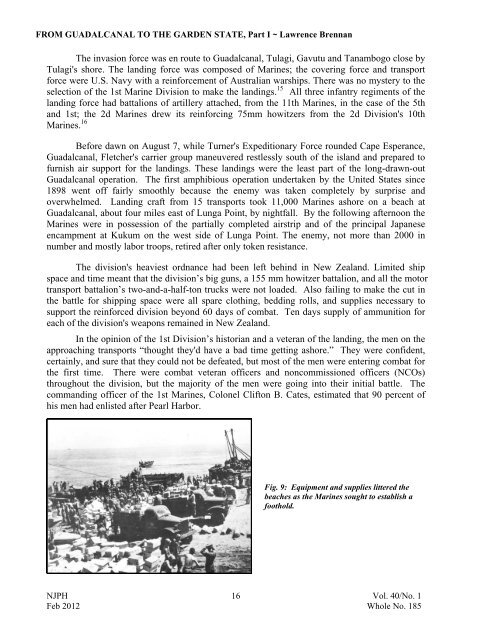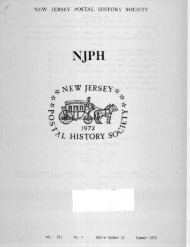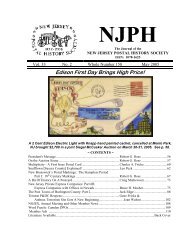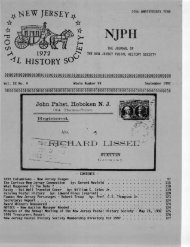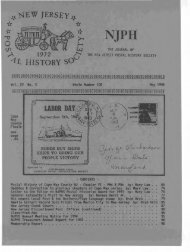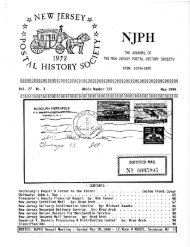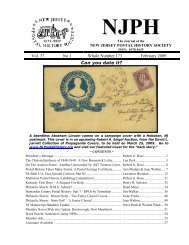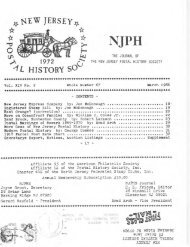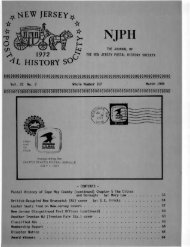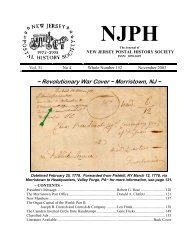185 - New Jersey Postal History Society
185 - New Jersey Postal History Society
185 - New Jersey Postal History Society
You also want an ePaper? Increase the reach of your titles
YUMPU automatically turns print PDFs into web optimized ePapers that Google loves.
FROM GUADALCANAL TO THE GARDEN STATE, Part I ~ Lawrence Brennan<br />
The invasion force was en route to Guadalcanal, Tulagi, Gavutu and Tanambogo close by<br />
Tulagi's shore. The landing force was composed of Marines; the covering force and transport<br />
force were U.S. Navy with a reinforcement of Australian warships. There was no mystery to the<br />
selection of the 1st Marine Division to make the landings. 15 All three infantry regiments of the<br />
landing force had battalions of artillery attached, from the 11th Marines, in the case of the 5th<br />
and 1st; the 2d Marines drew its reinforcing 75mm howitzers from the 2d Division's 10th<br />
Marines. 16<br />
Before dawn on August 7, while Turner's Expeditionary Force rounded Cape Esperance,<br />
Guadalcanal, Fletcher's carrier group maneuvered restlessly south of the island and prepared to<br />
furnish air support for the landings. These landings were the least part of the long-drawn-out<br />
Guadalcanal operation. The first amphibious operation undertaken by the United States since<br />
1898 went off fairly smoothly because the enemy was taken completely by surprise and<br />
overwhelmed. Landing craft from 15 transports took 11,000 Marines ashore on a beach at<br />
Guadalcanal, about four miles east of Lunga Point, by nightfall. By the following afternoon the<br />
Marines were in possession of the partially completed airstrip and of the principal Japanese<br />
encampment at Kukum on the west side of Lunga Point. The enemy, not more than 2000 in<br />
number and mostly labor troops, retired after only token resistance.<br />
The division's heaviest ordnance had been left behind in <strong>New</strong> Zealand. Limited ship<br />
space and time meant that the division’s big guns, a 155 mm howitzer battalion, and all the motor<br />
transport battalion’s two-and-a-half-ton trucks were not loaded. Also failing to make the cut in<br />
the battle for shipping space were all spare clothing, bedding rolls, and supplies necessary to<br />
support the reinforced division beyond 60 days of combat. Ten days supply of ammunition for<br />
each of the division's weapons remained in <strong>New</strong> Zealand.<br />
In the opinion of the 1st Division’s historian and a veteran of the landing, the men on the<br />
approaching transports “thought they'd have a bad time getting ashore.” They were confident,<br />
certainly, and sure that they could not be defeated, but most of the men were entering combat for<br />
the first time. There were combat veteran officers and noncommissioned officers (NCOs)<br />
throughout the division, but the majority of the men were going into their initial battle. The<br />
commanding officer of the 1st Marines, Colonel Clifton B. Cates, estimated that 90 percent of<br />
his men had enlisted after Pearl Harbor.<br />
Fig. 9: Equipment and supplies littered the<br />
beaches as the Marines sought to establish a<br />
foothold.<br />
NJPH 16<br />
Vol. 40/No. 1<br />
Feb 2012 Whole No. <strong>185</strong>


